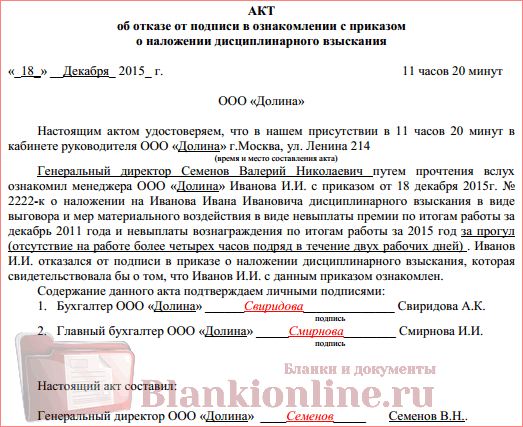When and why do they draw up an act?
Refusal to familiarize yourself with the management order is drawn up in conflict situations at the enterprise. Often an “offended” employee goes to court to sort things out. If the main evidence of violations against him is the inability to familiarize himself with the order, then such an act will become an argument against him. In controversial situations, it is important to timely and correctly draw up a document that will protect the company from unscrupulous employees during court proceedings.
Most often, such acts appear due to reprimands or dismissal of a person. This is often due to a negligent attitude to work, refusal to perform duties, absenteeism, and tardiness. To punish a negligent employee, for example, for systematic lateness, the employer acts in stages:
- Draws up a report of lateness.
- Tries to take an explanatory note.
- Issues a reprimand order.
When the violator refused to familiarize himself with it, then you will need paper that will record this fact. A similar document must be drawn up even if he read the text of the order, but did not want to sign. If an employee considers the manager’s actions unfair or illegal, he has the right to demand that his opinion be included in the document.
ConsultantPlus experts examined the question, when an employee refused to familiarize himself with the dismissal order and the employer drew up a report about this, but did not make a note on the order itself, whether the absence of a record of refusal to familiarize himself with the order is grounds for bringing this employer to administrative liability. Use these instructions for free.
In practice, there are several reasons for refusing to sign an autograph on an order:
- strongly expressed disagreement during familiarization;
- physical inability to see the document;
- expiration of the period provided for familiarization with the paper.
If an employee is physically unable to read the information, then this must be indicated. But this doesn't happen often. To draw up a document refusing to sign due to failure to meet deadlines, you should wait until they expire. If completed earlier, it will be invalid.
Violators often naively believe that the court will side with them if they do not sign the paper. This will not save them, since a person has the right not to autograph a document, but is not able to deprive it of legal force. The act of refusal will just confirm that the order was shown to the employee.
What to do if an employee refuses to sign an order
When faced with obstacles to the implementation of the administrative document, the employer must take care of drawing up a document recording the attempt to conduct familiarization and the employee’s refusal to sign the order.
- How to write a memo: sample drafting rules
Although there are no uniform requirements for drawing up a document, refusal to sign a dismissal order presupposes compliance with the standards mentioned in GOST R 6.30-2003.
The act is classified as information and reference documentation, which includes 3 sections:
- An introductory part indicating the details of registration (number, date of the document) plus a description of the composition of the commission. The list of citizens on the commission changes over time.
- Description indicating the facts, circumstances of the case, with the formulation of conclusions in relation to a specific person holding a certain position.
- List of commission members who certified the employee’s refusal.
The text content also indicates the number of copies compiled. The document is drawn up with the participation of the personnel service and the involvement of 2 witnesses.
Registration procedure
To comply with legal requirements, the employer must take the following actions:
- If a person refuses to sign, recording his familiarization with the order, the administration invites 2-3 employees who will serve as members of the commission. When selecting the composition of the commission, they try to avoid including direct subordinates.
- The employer, in the presence of witnesses, offers the employee an order to review and sign.
- If an employee verbally declares his reluctance to get acquainted with the order, it is read out in the presence of the commission.
- An act is drawn up recording the refusal to sign. To save time, the form can be prepared in advance, knowing that the person disagrees.
- The document is signed by members of the commission and the employee, if he expresses a desire to record his refusal in writing.
- An entry “Refused to review” is included in the act, confirming the fact with the signatures of witnesses.
The recording of disagreement with signing and familiarization is done manually, and the form itself can be printed on a printer in advance.
Download: Certificate of Refusal to Sign (form in Word) (25.5 KiB, 1,330 hits)
Upon completion of the paper, you must register it by assigning a number and indicating the date.
The employer himself is interested in the correct execution of the act and its subsequent storage at the enterprise, since this is the only paper that will help prove that the administration has taken measures to inform the person. For the person who refused, the presence or absence of the act does not make any legal difference, but for recovery after an inconsistent dismissal, justification for the lack of notification will provide serious assistance.
How to draw up an act
A single form is not necessary; a free design style is quite suitable. They are often drawn up on letterhead, but are also allowed on a regular A4 sheet, on a computer or manually. But then you need to provide all the details. If the main part is made on a computer, then you should remember that signatures are written manually with a ballpoint pen with dark ink. No pencils or markers.
The structure requires several sections:
- The header of the document is the name of the act and number, the city in which the company is registered, and the date of registration.
- Contents - information about a citizen who refuses to sign a document (full name and position), an order that he did not like (number, date). Witnesses and their details (names and positions). Here, if possible, indicate the date and exact time of refusal of the order.
- Space is left for autographs of event participants. Indicate the positions and surnames of the employee who refused to sign the original document, and witnesses, their signatures with transcripts.
- Below we indicate that the employee refused to sign this document. We leave room for the employee to explain (which rarely happens). If he reported it at least orally, then the compiler has the right to write it down. But more often you have to write that there was nothing to motivate you.
The document is prepared in two copies. One is for a careless employee, the other is left at the company.
Form
You are allowed to use a free filling style. But at the same time, all important data must be present here. Although you can use standard templates that are available for download on the Internet. Here you just need to fill in the blank lines, entering the relevant information into them.
In what situations is it issued?
If the act is drawn up correctly and on time, the company protects itself from possible problems in the future.
After all, in difficult relationships, situations are not excluded when an “offended” employee turns to court for help. At the same time, he can try to prove that the director did not familiarize him with the order. In this case, the company will be able to prove its case with the help of this act. After all, this confirms that the employee is nevertheless familiar with the order. This argument can be called quite weighty. If the document is drawn up correctly, the court will side with the organization. It also happens that at some certain moment an employee does not have the physical opportunity to sign his autograph. In this case, the correct decision on the part of the employer would be to put an appropriate mark in the act, which will confirm this fact. Often the preparation of such an act foreshadows a reprimand, disciplinary punishment, or dismissal. It can be assumed that the document indicates an unpleasant situation is brewing. Often, on its basis, a dismissal order is drawn up.
( Video : “If an employee refuses to familiarize himself with the order - Elena A. Ponomareva”)
Rules for drawing up an act of refusal to familiarize yourself with an order
The legislation does not establish specific requirements either for the form of the act or for its content. Based on the semantic purpose of this document, the following are important for reflection in it:
- date, time and place of its compilation;
- information about the employee who drew up the report and the persons who were present as witnesses;
- details of the remaining unsigned order;
- handwritten signatures of persons involved in the procedure for creating an act of refusal to sign.
It may also contain a reference to an article of the Labor Code of the Russian Federation, which contains a mention of the execution of such an act, as well as other information significant for the situation that has arisen.
Sample act of refusal to familiarize yourself with the order
Why is it necessary to record the fact of refusal?
The need to draw up an act of refusal to familiarize yourself with the order is due to the fact that the absence of an employee’s signature on this document can be regarded as a deliberate concealment of its text from the person to whom the order relates. Having a document indicating that the contents of the order were communicated to the employee and his refusal to sign it will help in the future to avoid controversial situations or resolve the dispute in favor of the employer.
To confirm the fact that the employee was familiarized with the contents of the order, at the time of refusal to sign it, an act is drawn up in which it is necessary to record:
- the presence of such a refusal;
- information that the contents of the document were brought to the attention of the employee by reading it out loud;
- the reasons that the employee named did not allow him to sign the acquaintance.
How to draw up an act of refusal to familiarize yourself

The act can be drawn up in free form, but when drawing it up, it is necessary to take into account some mandatory details:
- Information about the author of the act – full name and position.
- Information about the person who refuses to sign the order - full name and position.
- When drawing up the document, the witnesses to this refusal must be indicated, indicating their positions and full names.
- Time and place of drawing up the act.
- The details of the order must be indicated - the date of its preparation and its number.
- If the reason for refusal is known, it must be reflected in the act.
- The act must be certified by at least two witnesses.
A correctly drawn up document can protect the employer from possible labor disputes that may be initiated by the employee.
Who draws up an act of refusal to familiarize with the order in 2021
As a rule, a personnel officer is appointed responsible for drawing up this document. Although it is possible that the manager will appoint someone else to perform this function. In general, there are a number of actions that an employer must take if he is faced with such a protest from a subordinate.
So, it is recommended to follow this algorithm:
- the director hands over the document to the employee for review. This must be done in the presence of witnesses;
- usually, if an employee does not want to get acquainted with a document against signature, he informs about this orally;
- further, in the presence of the same witnesses, the order is read aloud to the employee;
- the next step is the immediate execution of the act, which indicates that the employee does not want to sign his autograph;
- it is possible that the employee will not make contact at all, and therefore will not sign the document. In this case, the director puts a corresponding mark here. This fact is confirmed by witnesses who must also sign the document.
It is necessary to understand that not only signatures are affixed “live”. A note is also made by hand indicating that the employee refuses to sign his autograph on the document.








